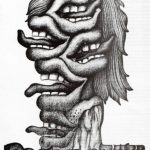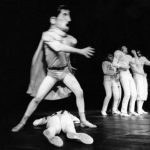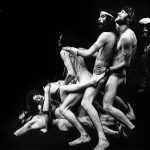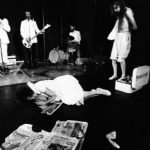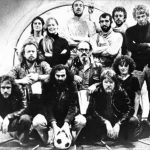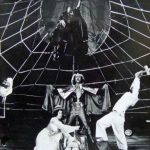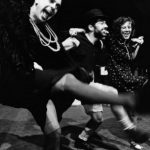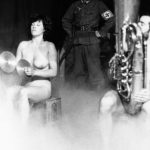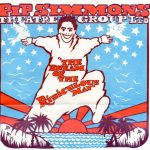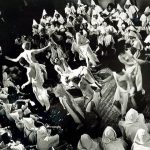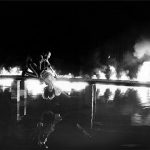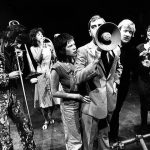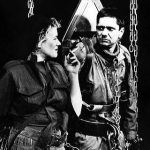Company Name: Pip Simmons Theatre Group
Founder: Pip Simmons
Established: 1968
Reason: Having spent ‘a very disillusioned time at New College Theatre School’ Simmons wanted to create a director-led touring company that would initially give him the opportunity to stage European modernist works especially those ‘involved in the rhythm of words – the musicality of language’ . Later Simmons fused Artaud’s ideas of ‘total theatre’ with the excitement of rock and roll to create challenging social critiques. ‘Rock ’n roll is something very exciting in its own right – but it also contains all the elements of social disintegration – the area in which our group works’. (Simmons in Ansorge, 1972)
Current Status: The last production of the Pip Simmons Theatre Group was in 1985
Area of Work: Experimental and Political
Policy: ‘The Pip Simmons Theatre Group had no philosophy when it was formed, has no philosophy now, will never have any philosophy; which somewhat removes the possibility of it ever becoming a didactic mouth-piece from a left wing, right wing, left half, centre forward, centre back, goalkeeper’s point of view. From this statement one imagines all kinds of trendy refutations of modern political theatre: on this assumption one would be absolutely correct. We try to be many things, not negative but apolitical and ultimately, we hope, objective’. (Publicity material, 1972)
Structure: As a director-led company many of the internal conflicts that characterise touring groups were avoided and there was a surprising continuity in personnel over the two periods of the company existence (1968-73 and 1974-1985). Pip Simmons and Chris Jordan’s close artistic collaboration provided a clear artistic vision for this fairly large touring unit of 6 to 8 performers. In devising their own productions, company members’ expertise was drawn upon – Paddy O’Hagan designing masks, Eric Loeb credited with ‘movement’ and later Emil Wolk brought skills in physical theatre. Most of the company had—or acquired—musical skills and ‘actors’ would double up in Jordan’s on-stage band – including Jordan himself who played the central role of Prospero in The Tempest, for example. The company had an independent administrator – in 1970, Ed Cottrell took on this role, followed by Carolyn Hutchinson and later Joan Oliver, Andrew McAlpine and, eventually, Arts Admin.
Based: Initially based in London, later with significant residencies in Europe
Funding: They were successful at attracting Arts Council funding on the basis of being a touring company – later they were frustrated at the difficulty of securing funding for ways of working other than an exhausting touring schedule. In 1978 their Arts Council grant was cut by £12,000 on the grounds that they hadn’t toured Britain in the previous year. Pip Simmons: ‘The Arts Council is much more in gear with stimulating writers and artists because it’s much easier and cheaper to do that. To finance a group like us to experiment is expensive, perhaps £50,000 a year’. (Coveney,1978)
Performance venues: Arts Lab, New Arts Lab, Oval House, Young Vic, Royal Court Theatre, ICA, Tricycle, Riverside Studios London, Nuffield Theatre Southampton, Birmingham Arts Lab and Brum Studio Birmingham, Haymarket Leicester, Phoenix Leicester, Gulbenkian Theatre Newcastle, Crucible Sheffield, Grand Theatre Leeds, Leeds University, Liverpool Everyman, Gardner Centre Brighton, York Arts Centre, Exeter Northcott, University of Bradford, Bingley College, Bristol University, Lancaster University, Keele University, Rochdale, University of Warwick, Guildford, Lowestoft, Norwich, Canterbury, Oxford, Nottingham University, Winchester, Cheltenham, Sunderland, Warrington, Leamington, Sherman Theatre and Chapter Arts Cardiff, Aberystwyth, Traverse Theatre and Cranston St. Hall (Festival) Edinburgh, Glasgow Citizens. France: Nancy, Paris, Nice, Avignon, Bordeaux, Cannes, Aix-en-Provence, Caen, Amiens, Nevers, Grenoble, Macon, Tours, Sceaux, Dijon, Douai, Mulhouse, Thonon-les-Bains, Lyons, Aurillac, Chartres, Chambéry, Béziers, Bourges, Grasse, Lille, Mende, Privas. Italy: Milan, Rome. Germany: Hamburg, Munich, (West) Berlin, Bonn, Cologne, Duisburg, Marl, Lage, Siegen. Belgium: Brussels, Antwerp. Yugoslavia: Belgrade, Zagreb. Holland: Mickery Theatre Amsterdam, Piccolo Theater Rotterdam, The Hague, Utrecht, Groningen, Enschede, Tilburg, Eindhoven, Apeldoorn, Nijmegen, Leiden, Haarlem, Dordrecht. Sweden: Stockholm, Östersund. Denmark: Holstebro, Copenhagen, Herning, Louisiana, Viborg, Odense, Aalborg, Tastrup, Aarhus, Kolding, Hillerod. Norway: Stavanger, Oslo. Austria: Vienna, Switzerland: Zurich.
Audiences: Initially they played extensively on the emerging circuit of universities, colleges, arts labs and festivals. They were probably the most commercially successful of all the small touring fringe groups at the time and were even more popular in Europe than in the UK. In Europe there were larger venues interested in presenting their work and paying accordingly. This also enabled longer preparation time and better performance facilities.
See here for Tributes to the late Pip Simmons (1942-24) by Sheila Burnett and Ruud Engelander
Gallery:
For photographs of the Pip Simmons Theatre Group on tour see Sheila Burnett’s Unfinished Histories page and www.sheilaburnett-headshots.com/blog/
Company work and process: Pip Simmons set up the theatre group in 1968 under Jim Haynes’s open-door policy at the Drury Lane Arts Lab. Simmons had just finished a three year course for drama teachers at the New College of Speech and Drama, Hampstead and it was obvious for him to look to contacts at the school for company members. Chris Jordan, from the year below, started working with Simmons on a number of short theatre pieces in the European modernist mode – surrealist, expressionist and absurdist – whilst he was in his final year at the college. Tardieu’s Underground Lovers, a new translation of 12 experimental plays, had just been published in the UK and provided the inspiration for the group’s first full-length production. Chris Jordan, a musician, composer and performer now joined the company on a full-time basis and the creative collaboration between Simmons and Jordan found its first voice in a musical adaptation of Chaucer’s The Pardoner’s Tale . The partnership was central to all of the group’s subsequent work. Time Out noted how the company had ‘…evolved their own style of music and movement to put across strong and simple stories with the maximum directness and impact – almost like a modern pop-type version of a medieval morality play’ (October 1970).
Counter-culture Stance
Following a pattern set by The People Show and Portable Theatre – companies also initially based at the Arts Lab and later at Oval House – Pip Simmons Theatre Group exhaustingly travelled the country and Europe performing on an ‘underground’ touring circuit of arts labs, university and college venues. All three groups took a combative approach to liberal, middleclass theatre and theatre audiences. Simmons’s counter-culture stance is illustrated in publicity material from 1972. ‘The style of our performances … is dictated almost purely by our distrust of the nauseating, boring pap which most modern movements can justify intellectually to a small intellectual minority of aware theatregoers; our attempt is to take those same sane intelligent people and rape their theatrical sensibilities by whatever means are at our disposal. We have varying degrees of success but the Liberal target is an evasive one…’
Superman and Do It!
Lu Jeffrey also from New College joined the company – now six – and Ed Cottrell was administrator. Their next production Superman was the first of three works to demonstrate what Peter Ansorge (1975) saw as a ‘love-hate relationship’ with Americana. Superman was the result of four months’ preparation and continued to evolve through its 250 performances and various cast changes (Simmons, 1972). It used, as its starting point a comic book story ‘Rock ’n’ Roll Superman’ and a less obvious reference to Friedrich Nietzsche’s concept of ‘superman’. Jordan’s songs provided an important structuring element for this company devised piece. As in the group’s subsequent work, Simmons gave the actors creative freedom to develop ideas and sequences while he remained the final arbitrator as to what worked and would remain in the show.
Mike Rudman (Traverse Theatre) commissioned their next show Do It!. Based on Jerry Rubin’s book, it covers the anti-war protests at the Democratic National Convention in Chicago in 1968 and the subsequent trial of the Yippee leaders – the Chicago Conspiracy Trial. By now the company had evolved a powerful house style which combined theatrical excess – smoke machines, strobe lighting, masks, nudity and profanity with a direct form of address that challenged audience with regards to their stance on the material. Rudi Engelander recalls that ‘the confrontational aspects of [the] work could be quite scary’. Reflecting on the show a few years later, Simmons described a performance at Southampton University when ‘about thirty people joined the actors in running through the audience. It was like a madhouse’. (Ansorge, 1972)
Alice and George Jackson
Alice in Wonderland was a particular favourite production of Simmons who described it as ‘… the[ir] least pretentious. I was interested in the rhythms and characters, its nightmarish aspect, the grotesque aspect of fairy tales – [through performance] it got so different from what we originally made’ (Hammond, 1973). Lu Jeffrey recalls that the key decision to have two Alice’s – one male and one female – was arrived at by the serendipity of the rehearsal process rather than through an analysis of the text (Jeffrey, 2013).
In late 1972 Alice was followed by The George Jackson Black and White Minstrel Show – a return to political controversy. Confronting ideas about slavery and race – the show takes the form of a minstrel show with George Jackson (the Black Panther activist who had been killed in 1971 whilst attempting to escape from prison) as the central character. The all-white cast were ‘blacked-up’—apart from ‘Mr. Interlocutor’, the ringmaster, who was ‘whited-up’—and in a characteristically provocative challenge to the audience’s values, a slave auction left cast members chained to some of the audience during the interval. Perhaps anticipating criticism from the onset they previewed the show ‘to a group of Black Panthers at the Oval – young black working class militants based at Brixton and Lambeth …. It was a very tense evening. I think they understood it better than most other audiences, who don’t care [about the issues]’ (Hammond, May 1973). Although the show divided audiences and critics it was another commercial success. An American tour for the George Jackson show was mooted but didn’t go ahead. Simmons had doubts about the sustainability of the group: ‘We didn’t want to go on repeating ourselves to the point where everybody had expectations of what our shows were going to be…’ but the pressure of constant touring was an even more decisive factor ‘… ‘It’s just physically impossible to go on touring, because its bloody hard work, it’s a long day and it’s very debilitating to the spirit’.
The End of the First Company
The Pip Simmons Theatre Group disbanded in April 1973. Chris Jordan and Warren Hooper formed a rock theatre group – Nice Pussy for which Jordan composed an ‘epic musical-drama Miles Apart and Dave and Goliath.’ Simmons went to Europe to work on one-off productions including The Baader-Meinhof Show. Without his company regulars, Simmons encountered difficulties working on this production. Initially planned for Hamburg it was dropped as being too controversial. Baader- Meinhof was finally staged under Peter Zadek’s patronage at Bochum (also in Germany). ‘…The project didn’t work out that well, because the actors couldn’t generate the deep commitment needed for a Pip Simmons production – such as in the direct confrontation with the audience.’ (Engelander, 2015)
The Children of the Night (What Music They Make)
Ritsaert ten Cate, of The Mickery Theatre, was an enthusiastic supporter of Simmons’s work – all their shows played at the Mickery. Through his influence Simmons got a nine month residency at the Toneelraad, Rotterdam to create two productions on the theme of ‘horror’. With Rudi Engelander on hand to liaise with the Dutch authorities, Simmons set up a ‘new’ company with the epithet – ‘The Children of the Night (What Music They Make)’. Chris Jordan and Eric Loeb from the original company were joined by Peter and Joan Oliver (administrator) of Oval House and Emil Wolk who had expertise in physical theatre. Jordan brought in Rod Beddall from Nice Pussy and as Lu Jeffrey was unable to join the company because of illness, Beddall’s then partner, Sheila Burnett, took her place. Rowan Wylie being a second female performer. For the extent of the residency the company were given accommodation in two houses at Rotterdam.
At last the company were freed from the necessity of creating shows that could ‘fit into the back of a van’. Elaborate staging was experimented with in the first show of the residency – an adaption of Bram Stoker’s Dracula. The set took the form of a giant spider’s web – maintained under tension to enable the performers to hang from and climb around the web. Wolk describes it as ‘a straight forward … piece of popular rock-based theatre …. Rod Bedall played this ‘rock’ Dracula – he looked amazing, quite sado-masochistic, fishnet stockings …. the rest [of the characters were] very Victorian’ (ref. Wolk, 2015).
An Die Musik
The second ‘horror’ piece An Die Musik was in direct contrast to Dracula. Rudi Engelander, whose Jewish father had died in Auschwitz, suggested doing a production about an orchestra in a concentration camp. Unusually Simmons checked out how such a show might be received with an esteemed Dutch theatre critic who had some experience of Auschwitz projects. The show went ahead. The first part – ‘The Dream of Anne Frank’ was played out in a grotesque Expressionistic style whilst the second part culminated in the gassing of the concentration camp orchestra. An Die Musik was a different form of confrontational theatre. This time audiences were placed in a passive role in relation to the cruelty being enacted on stage, an echo of the complicity that the German people had been accused of in relation to the Holocaust. For the production the audience sat on quite uncomfortable benches, they ‘…. were really grabbed by the cruelty and violence on stage – it was a very physically demanding performance.’ (Engelander,2015). Whilst it divided audiences ‘…the critic of the Jewish Chronicle, David Nathan, was unstinting in his praise, as were many concentration camp survivors, the group encountered in Holland. In Paris [however], Maoists disrupted a performance, claiming the show took no account of (their) historical perspective’ (Coveney 1978). The production was taken to the Nancy Festival and went on an extensive European tour including playing the ICA Theatre.
The Dream of the Ridiculous Man
In the Spring of 1975, the group were encouraged to return to London with the offer of a subsidy by the Arts Council of Britain. Simmons had wanted to adapt Dostoyevsky’s The Dream of the Ridiculous Man for a while and its ultimately optimistic celebration of life provided a contrast to the darkness of An Die Musik. Roderic Leigh played the ‘Ridiculous Man’ who initially considers suicide but through a series of dreams and encounters comes to value life. Wolk remembers audiences ‘loving it’. The show opened with Jordan’s music and the company doing Tai Chi movements. Wolk played Doctor Death on stilts studded like a punk rocker with a shaven head. ‘There was a lot of nudity in it, it wasn’t gratuitous it was just the situation that the character was in – such as Leigh being exposed when turned upside down in his nightshirt!’
Immersive Productions
Whilst the Arts Council favoured funding touring companies, Simmons saw residencies as a more satisfactory way of creating theatre. A residency at the Mickery resulted in a promenade performance of an adaption of Edgar Allen Poe’s The Masque of the Red Death utilising the whole building and ‘mobile screens were raised and lowered in conjunction with a variety of playing spaces to create the optimum spatial environment for the audience of each scene’ (Barker , 1979). Mik Flood of Chapter Arts Cardiff describes a similarly immersive production of Woyzeck which was the result of a residency there – also in 1977: ‘…The show took over virtually every part of the building, to the point where I built this bloody great lake outside for the final scene – which we set fire to every night.’ Simmons explains that ‘… with Woyzeck you had a narrative progression through the rooms. We re-edited the play to make a narrative progression ….we always work on the basis that the theatre is essentially a live performance. What is live about it is the people on stage, the people sitting in the audience and the space’
More Residencies
The company were typically playing 100-200 seater venues in this country and 500-1000 seater venues abroad and Simmons cites touring productions of Dracula and Shakespeare’s The Tempest as productions that suffered from the difficulty of adapting to a very different space to that which it was initially planned for. In contrast We, an adaption of Yevgeny Zamyatin’s futuristic novel, was planned with residencies at three collaborating centres Cardiff, Newcastle and Birmingham. This met the Arts Council’s criteria for touring theatre whilst also enabling the company to create a show within its performance space. A longer than usual rehearsal period of 8-9 weeks enabled the company to ‘utilize light / sound montages in very complex ways’ and the production also involved a considerable amount of video equipment through monitor sets and ‘eidophor’ screens (an early version of large screen video projections). The acting style was characterised by physical poses and movement based upon Meyerhold’s bio-mechanical training methods (Barker,1979).
Verbatim Theatre and Back to Basics
At the turn of the 80s the company returned to small scale productions with two very successful touring shows: Towards A Nuclear Future and Rien Ne Va Plus. Both shows were extensively researched and whilst retaining the company’s hallmark theatricality and the integral use of Jordan’s music for the onstage band – they were also early examples of verbatim theatre. In Towards A Nuclear Future all words were taken from nuclear experts, employees and activists. As with the earliest Pip Simmons shows, the company challenge the audience to form their own stance in response to the compelling presentation of contradictory evidence.
The End of the Company
After these two touring shows, Peter and Joan Oliver left in 1981 to set up their own theatre company Midway Enterprises and the Pip Simmons Theatre Group mainly worked on the Continent for the next few years. Returning in January 1985 with an adaptation of Kafka’s In the Penal Colony that had been developed as part of the Mickery Theatre’s ‘Beyond Television’ season, it continued Simmons’s interest in using video technology to experiment with the spatial relationship between the performer and audiences. This was the company’s last major show. Pip Simmons went on to develop various projects in Europe and some were presented under the name ‘The Pip Simmons Group’. Chris Jordan continued to work as a composer, lyricist and performer in music theatre especially associated with Denmark’s Odense International Music Theatre company. In 2000 Simmons and Jordan were both involved in a revival of An Die Musik with the Jewish Theatre of Bucharest.
Reviews:
‘…As exciting as the Stones live. Rubin sent up, brought down and the new American dream dissected. Sex, dope and cheap thrills.The fastest show on earth. Energy, energy, energy. Fuck analysis – get out there and Do It!’ (Time Out, May 1971)
‘This Alice in Wonderland is a multi-media spectacle… the Pip Simmons Theatre Group succeeds in mixing all the diverse variations of theatrical expression and this is what makes their funny, grotesque show so worth seeing.’ (Tagesspiegel, Berlin January 1972)
‘…by moving from dream to reality and by placing the audience in the same position as the guard, Simmons deliberately emphasized the voyeuristic way we regard the tragedies of history: our attitude of pity for the victims of the past serves only to mask our fundamental acceptance of the necessity of history’ Sandy Craig on An Die Musik in Dreams and Deconstructions (Amber Lane Press, 1980) .
‘Pip Simmons has the most terrifying mind I have encountered in the London theatre. It is to be hoped for the happiness of his soul that he does not himself realise all that is suggested by its dark recesses’ (Harold Hobson, The Sunday Times, 6 July 1975 on An Die Musik)
‘Customers squat on raised planks in front of a sandpit adorned with bits of old wood and billowing white muslin. Upstage Prospero in a Robinson Crusoe straw hat summons the storm on a moog synthesiser.’ (Financial Times, 10 May 78 on The Tempest)
Personal appraisal and thoughts:
Productions:
| PRODUCTION NAME | VENUE | DATES |
|---|---|---|
| The Masque Routine Adapted from The Protagonist by George Kaiser Directed by Pip Simmons Cast: Chris Bostock, Maurice Colbourne & others | Drury Lane Arts Lab | 27-29th September 1968 |
| Sand Written by Murray Mednik Directed by Pip Simmons Cast: Chris Bostock, Maurice Colbourne & others | Drury Lane Arts Lab | November 1968 |
| Conversation-Sinfonietta Written by Jean Tardieu Directed by Pip Simmons Cast: Chris Jordan, Paddy O'Hagan, Jeni Barnett & others | ||
| The Sonata and The Three Gentlemen Written by Jean Tardieu Directed by Pip Simmons Cast: Chris Jordan, Paddy O'Hagen & others | Drury Lane Arts Lab | December 1968 and Jan 1969 |
| The Hangman’s Sacrifice Written by René de Obaldia Directed by Pip Simmons | ||
| The Enquiry Office Written by Jean Tardieu Directed by Pip Simmons Cast: Chris Jordan, Paddy O'Hagen | ||
| The Underground Lovers Adapted from Tardieu’s collection of 12 experimental plays Directed by Pip Simmons Cast: Chris Jordan, Paddy O'Hagen, Ben Bazell, Annie Eills & others | Traverse Theatre Edinburgh Free Arts Festival Ealing College of Art | 25th October 1969 (Traverse) 5th December 1969 (Ealing) |
| The Hunting of the Snark Adapted from Lewis Carroll Directed by Pip Simmons Cast: Chris Jordan, Paddy O'Hagen, Ben Bazell, Warren Hooper | ||
| The Pardoner’s Tale Adapted from Chaucer Directed by Pip Simmons Music by Chris Jordan Cast: Chris Jordan, Paddy O'Hagen, Warren Hooper | Nancy Festival | 1971 (Nancy) |
| Superman Directed by Pip Simmons Music by Chris Jordan Cast: Ben Bazell, Glynis Earl / Lu Jeffery, Warren Hooper as Superman, Paddy O’Hagan, Annie Eills / Sue Watson, Chris Jordan, Eric Loeb Cast (Edinburgh & touring): Warren Hooper as Superman, Ben Bazell, Lu Jeffery, Paddy O’Hagan, Chris Jordan, Eric Loeb | Mickery Theatre, Granston Hall, Edinburgh Festival New Arts Lab London Royal Court (Come Together Festival) Traverse Theatre | 11th May 1970 (Mickery), August 1970 (Edinburgh) 12th October 1970 (Arts Lab) Oct 1970 (Come Together Festival) 12 January 1971 Traverse |
| Do It! Written by Pip Simmons and the company after Jerry Rubin’s Scenarios of the Revolution Music by Chris Jordan Masks: Paddy O’Hagan Movement by Eric Loeb Cast: Nicky Edmett (Rubin), Eric Loeb, Warren Hooper, Lu Jeffrey, Chris Jordan, Paddy O’Hagan, Ben Bazell | Oval House, Theatre Upstairs Royal Court, Traverse Theatre, Young Vic, Sheffield, Southampton, Leicester, The Mickery (and Holland tour), SIGMA Festival Bordeaux, BITE Festival Belgrade, ‘London Now’ Festival Berlin, Deutsches Schauspielhaus Hamburg, Nancy, Sweden and Denmark | December 1970 (Oval) 1971(Mickery) August 1971 (Royal Court) |
| Alice in Wonderland Adapted by Pip Simmons from Lewis Carroll Music by Chris Jordan Cast: Lu Jeffrey, Nicky Edmett, Ben Bazell, Warren Hooper, Paddy O’Hagan, Chris Jordan & others | Tour of Germany also played London | 1972 |
| The George Jackson Black and White Minstrel Show Devised and performed by the company Directed by Pip Simmons Music by Chris Jordan Cast: Nicky Edmett / Michael Kitching (Jackson), Eric Loeb, Lu Jeffrey, Warren Hooper, Paddy O’Hagan, Chris Jordan & others | Oval House The Mickery | Sept 1972 (Oval) 1973 (Mickery) |
| Dracula Adapted by Pip Simmons from Bram Stoker Directed by Pip Simmons Music by Chris Jordan Cast (Rotterdam): Peter Oliver, Rowan Wylie, Sheila Burnett, Rod Beddall, Emil Wolk, Friedrich-Karl Praetorius, Eric Loeb, Chris Jordan Cast (Royal Court &Touring 1976): Peter Oliver, Miraav Gary, Sheila Burnett, Rod Beddall, Emil Wolk, Peter Jonfield, Ben Bazell / John Stuart, Chris Jordan | Piccolo Theater Holland, Revived Glasgow Citizens, Studio Theatre (location?) Royal Court Theatre | opening date 14 Nov 1974 (Piccolo) March 1976 (Citizens) November 1976 (Studio) December 1976 (Royal Court) |
| An Die Musik From an original idea by Rudi Engelander Directed by Pip Simmons Music by Chris Jordan (and Schubert, Beethoven and Liszt) Cast (Rotterdam & Nancy): Peter Oliver, Rowan Wylie, Sheila Burnett, Rod Beddall, Emil Wolk, Friedrich-Karl Praetorius, Eric Loeb, Chris Jordan Cast (Touring): Peter Oliver, Rowan Wylie, Sheila Burnett, Rod Beddall, Emil Wolk, Peter Jonfield, Ben Bazell, Chris Jordan | Piccolotheater Rotterdam, Nancy Festival and European tour, ICA Theatre | 23 March 1975 (Rotterdam), 16 & 17 May 1975 (Nancy), 2 July 1975 (ICA) |
| The Dream of a Ridiculous Man Adapted from Dostoevsky by Pip Simmons Directed by Pip Simmons Music by Chris Jordan and the band Cast: Roderic Leigh (the Ridiculous Man), Ben Bazell / John Stuart, Rod Beddall, Sheila Burnett, Peter Jonfield, Chris Jordan, Peter Oliver, Emil Wolk and Rowan Wylie/ Miraav Gary | ICA Theatre Glasgow Citizens Birmingham Studio | October 1976 (Birmingham) 1977 (Glasgow) |
| The Masque of the Red Death Adapted by Pip Simmons after Edgar Allen Poe Directed by Pip Simmons Music by Chris Jordan and the band Cast: Roderic Leigh (Poe), Poppy Hands, Jill Hellerman, Jessie Gordon, Sheila Burnett, John Stuart, Chris Jordan, Peter Oliver, Rod Beddall, Steve Johnson | The Mickery Theatre | 1977 |
| Woyzeck by George Buchner adapted by Pip Simmons Directed by Pip Simmons Music by Chris Jordan and the band Cast (Chapter): Steve Johnson (Woyzeck), Roderic Leigh, Poppy Hands, Jill Hellerman, Jessie Gordon, Sheila Burnett, John Stuart, Chris Jordan, Peter Oliver, Rod Beddall. Cast (Touring): Peter Oliver (Woyzeck), Roderic Leigh, Poppy Hands, Jill Hellerman, Jessie Gordon, Sheila Burnett, John Stuart, Chris Jordan, Rod Beddall | Chapter Arts Centre Cardiff Later at Hamburg and Bonn | 1977 1979 (Hamburg and Bonn) |
| The Tempest by William Shakespeare Adapted by Pip Simmons with the company Directed by Pip Simmons Music by Chris Jordan. Cast: Roderic Leigh (Antonio), Sheila Burnett (Ariel), Rod Beddall (Caliban), Jessie Gordon (Ferdinand), Peter Oliver (Gonzo), Poppy Hands (Miranda), Chris Jordon (Prospero), Steve Johnson (Stephano) Lighting: Steve Whitson and Dick Johnson Masks: Maggie Jones | Riverside Studios London Newcastle University Theatre | Opening date 9 May 1978 (Riverside) |
| We Adapted by Pip Simmons from the novel by Yevgeny Zamyatin Music: Chris Jordan Cast: Rod Beddall, Sheila Burnett, Helena Fransson, Jessie Gordon, Chris Jordan, Sally Lansdale, Roderic Leigh, Peter Oliver | Birmingham New Arts Lab, Cardiff Chapter Arts, Newcastle on Tyne University Theatre, Mickery Theatre Theatre of Nations Festival in Hamburg, Bonn, Vienna and Munich | December 1978 (Newcastle) April 1979 (Mickery) |
| Towards A Nuclear Future Directed by Pip Simmons Music by Chris Jordan, Rod Beddall and Pete Gibson Cast: Roderic Leigh, Peter Oliver, Rod Beddall, Helena Fransson, Pete Gibson Jessie Gordon, Chris Jordan, Sheila Burnett, Sally Lansdale | Mickery Theatre Arts Centre (U. of Warwick) ICA Theatre | October 1979 (Mickery) January 1980 (Warwick) April 1980 (ICA) |
| Rien Ne Va Plus Written and directed by Pip Simmons Music by Chris Jordan Cast: Peter Oliver, Rod Beddall, Helena Fransson, Pete Gibson, Chris Jordan, Sheila Burnett | Birmingham Arts Lab Mickery Tricycle Theatre | 23rd Sept 1980 (Birmingham) December 1980 January 1981 (Tricycle) |
| Can’t Sit Still Adapted from Peter Pan by Chris Jordan and Pip Simmons Music by Chris Jordan Cast: Peter Jonfield, Rod Beddall, , Pete Gibson, Chris Jordan, Tina Jones, Willy Wilson, Bill Ward & others | Chapter Arts Centre Cardiff, Glasgow Citizens ICA Theatre Mickery Theatre | March 1982 (Cardiff) May 1982 (Glasgow) |
| Snuff Adapted from a Peter Cary story by Pip Simmons Music: Chris Jordan Cast: Pascal De Verwerre (Snuff), Chris Jordan, Roderic Leigh, Helena Fransson, Tina Jones, Phylis Roome | Béziers, Bourges & Paris | 1982 |
| In the Penal Colony Written and directed by Pip Simmons after Kafka Music: Chris Jordan Cast: Chris Jordan, Trevor Stuart, Sheila Burnett, Alex Mavro, Mieke Visscher, Henk Pauwels | ICA Theatre The Mickery | January 1985 (ICA) |
Interviewee reference: Rudi Engelander, Emil Wolk, Joan Oliver
Existing archival material: Unfinished Histories hold the Rudi Engelander archive relating to his work with Pip Simmons. If you would like access to these materials, please contact us using the contact details on our website. Arts Council archive held by V & A: ACGB/34/123 (5 folders covering the years 1976-1984).
Bibliography:
Superman by Pip Simmons in New Short Plays 3 (Methuen, 1972)
‘Made in USA’ by Peter Ansorge in Plays and Players, March 1972
‘A Requiem for the Fringe – Pip Simmons talks to Jonathan Hammond’ in Plays and Players May 1973
Disrupting the Spectacle by Peter Ansorge (Pitman,1975)
Towards a Nuclear Future published by Mickery Theatre, 1975
‘Rough Magic –Ten Years of the Pip Simmons Theatre Group’ by Michael Coveney in Plays and Players May 1978
‘Pip Simmons in Residence’ by Clive Barker in Theatre Quarterly No.35, 1979
‘From Reactors to Roulette – an Interview with Pip Simmons‘ by Gillian Clark in Performance Magazine No.8, 1980
Links:
Chris Jordan
Sheila Burnett
Ruud Engelander
Acknowledgements: This page was written by David Cleall with thanks to Chris Jordan for his help in providing information on casts and other production details and thanks also to Sheila Burnett for photo images.
Rudi Engelander and Emil Wolk were interviewed in relation to the development of this page in 2015. Additional details are taken from a recording of a presentation made by Chris Jordan, Lu Jeffrey and Sheila Burnett at the Re-Staging Revolutions launch on November 10th, 2013 at Oval House. John Fox and Sue Gill interviewed Joan Oliver for Unfinished Histories in 2015. If you would like to view or listen any of these materials, please contact us through the contact details on our website.

